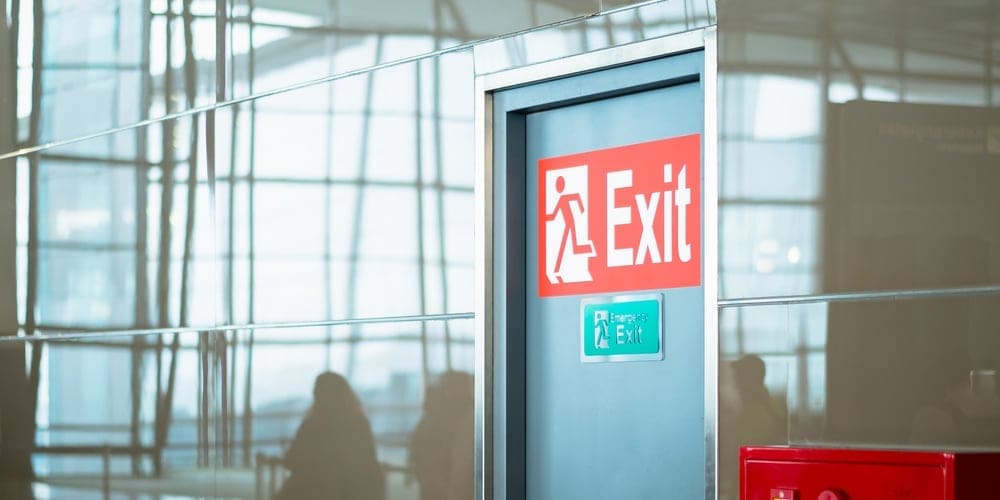Fire door locks are essential to building safety, especially during emergencies. I remember touring a modern office where robust steel fire door locks offered both security and swift egress. They prevent unauthorized access while making sure exits are readily accessible in a crisis. High-quality locks, such as mortise or electromagnetic varieties, self-lock under extreme heat and are vital for compliance with safety regulations. Regular maintenance, including lubrication and inspections, guarantees their reliability. Integrating these locks with access control and alarm systems further strengthens building security. Discover the essential tips on selection, installation, and integration for best emergency preparedness.
Introduction
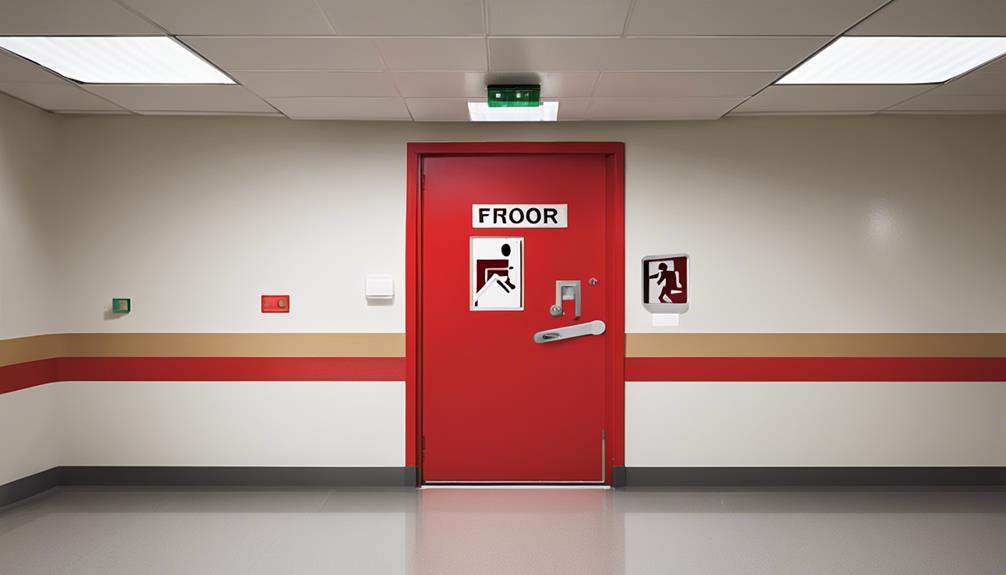
Fire door locks are an essential component in enhancing the security and safety of emergency exits in commercial buildings, providing a reliable means of ensuring both swift evacuation during emergencies and preventing unauthorized access. In this article, we will explore the crucial aspects of fire door locks, their installation, and their role in compliance with safety regulations. Readers will gain insights into how these locks function under extreme conditions and the benefits they offer in safeguarding occupants.
Brief overview of fire door locks and their importance in enhancing the security of emergency exits
Ensuring the integrity of emergency exits through the use of fire door locks is vital for both safety and security in any building. Fire door locks are not just a regulatory necessity but a critical component in protecting lives and property. They are meticulously designed to guarantee doors remain closed during a fire, thereby containing the spread of flames and smoke. I remember installing these locks in a commercial building; the peace of mind it provided was invaluable. These locks also prevent unauthorized access, ensuring only legitimate evacuations. By securing emergency exits, fire door locks help maintain compliance with safety codes and regulations, thereby fostering a safer environment. Their dual role in safety and security cannot be overstated.
Explanation of the article’s purpose and what readers can expect to learn
As we delve deeper into the subject of fire door locks, this article aims to provide thorough insights into how these critical components enhance emergency exit security and compliance in commercial buildings. Readers can expect to learn how fire door locks prevent unauthorized access and tampering, ensuring both security and swift evacuation during emergencies. Through detailed explanations, we will uncover the benefits of proper installation and how these locks contribute to compartmentalizing fires, thereby protecting building occupants. Personal anecdotes and industry examples will illustrate the significance of these mechanisms in real-world scenarios. By the end of this guide, you will have a thorough understanding of why fire door locks are indispensable for maintaining safety and regulatory compliance.
Understanding Fire Door Locks
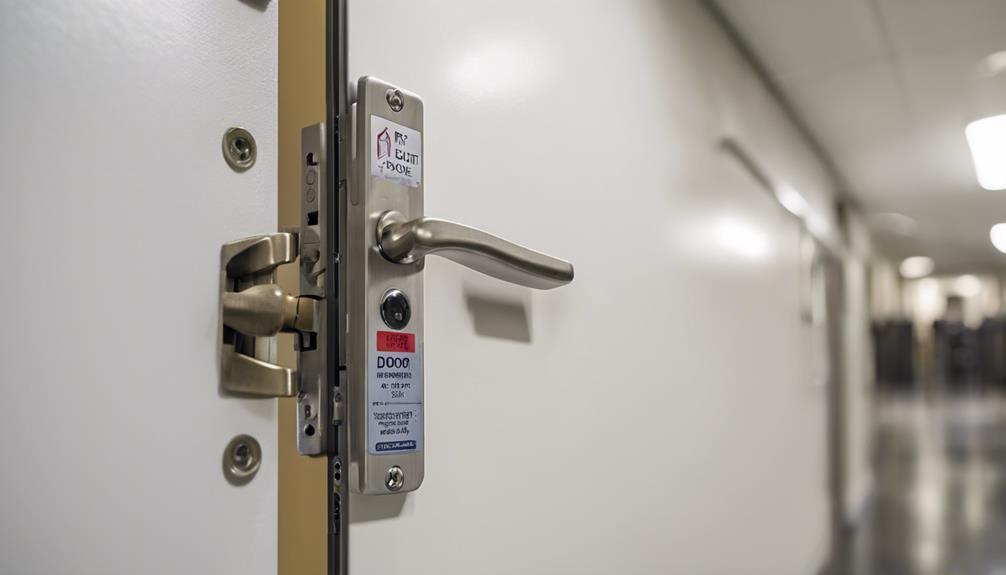
Understanding fire door locks is essential for ensuring both security and safety in emergency situations. These specialized locks comprise key components and mechanisms designed to maintain the structural integrity of fire doors while allowing quick, unobstructed exits. With various types of fire door locks available, selecting the right one involves considering functionality, compliance with building codes, and ease of use during crises.
Definition and function of fire door locks
Fire door locks play a pivotal role in maintaining a building’s safety by ensuring that fire doors remain securely closed during a fire, thereby preventing the spread of flames and smoke. These specialized locks are indispensable for upholding the integrity of fire doors, designed to withstand fire for at least one hour. I recall inspecting a commercial building and observing the essential difference that properly installed fire door locks made. They remain unfastened to allow swift evacuation but automatically fasten when exposed to extreme heat, ensuring containment. Improperly fastening these doors can severely compromise safety, hindering evacuation. Understanding the purpose and proper use of fire door locks is crucial for anyone seeking to enhance their building’s safety and security.
Key components and mechanisms
Exploring the intricacies of fire door locks reveals a fascinating blend of engineering and safety, where each component, from latch bolts to cylinder locks, plays a vital role in ensuring these life-saving doors function flawlessly during emergencies. Imagine this: latch bolts secure the door firmly, while deadbolts offer added strength. Strike plates ensure the lock’s alignment, and cylinder locks provide the key control. During my last safety audit, I witnessed how panic hardware could be effortlessly engaged, allowing for swift egress even in high-stress scenarios. These mechanisms are not just parts; they are the guardians of safety, meticulously designed to maintain the door’s integrity and effectiveness in containing fires, offering peace of mind when it matters most.
Types of fire door locks available
When considering the diverse range of fire door locks available, it becomes clear how each type—from the robust mortise locks to the streamlined panic bars and advanced electromagnetic locks—offers unique advantages in ensuring the safety and efficiency of emergency exits. Mortise locks, installed within the door, provide a traditional yet reliable solution that I’ve often found indispensable in older buildings. Meanwhile, panic bars allow for swift egress by simply pushing the door, a feature I’ve personally seen save precious seconds during emergency drills. Electromagnetic locks, controlled by access systems, offer cutting-edge security, blending seamlessly into modern infrastructures. Understanding each lock’s functionality and proper use is crucial for maintaining top safety and control over emergency exits.
The Role of Fire Door Locks in Emergency Exits
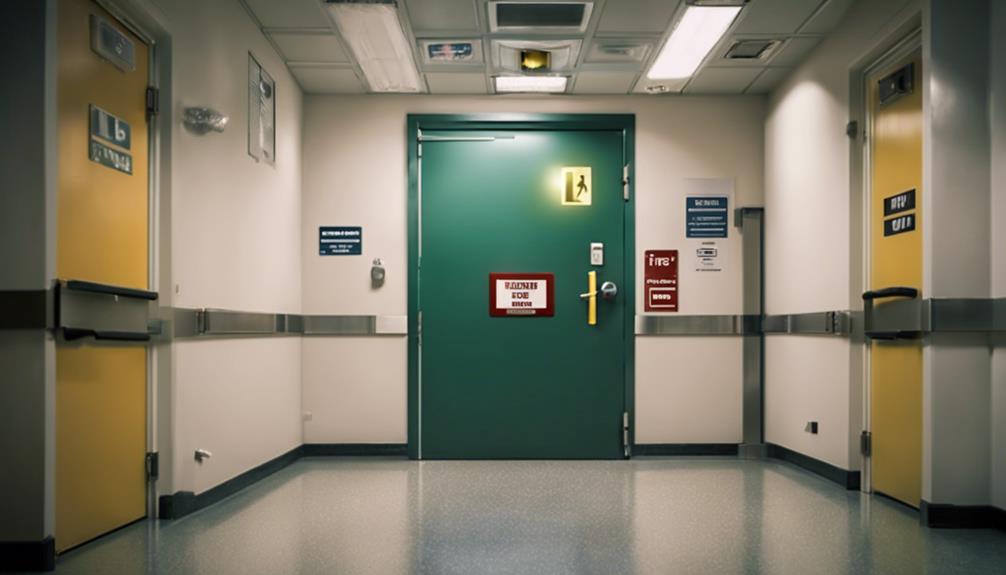
The indispensable role of fire door locks in emergency exits cannot be overstated, as they guarantee both security and swift evacuation during crises. Adhering to stringent legal requirements and safety standards, these locks provide a critical balance between accessibility and protection. Through numerous real-life examples, such as the successful evacuation during the 2017 Grenfell Tower fire, the effectiveness of well-maintained fire door locks becomes abundantly clear.
Importance of fire door locks in emergency scenarios
Fire door locks are indispensable assets in emergency scenarios, guaranteeing both the containment of hazards and the facilitation of swift evacuations. During a fire in my office building, the fire door locks played a crucial role. They prevented unauthorized access, keeping the emergency exits clear. This allowed everyone to exit quickly and safely. Fire door locks not only contain the spread of fire and smoke, protecting occupants, but also ensure that emergency exits remain accessible. This dual function is essential for maintaining security and safety. By preventing individuals from blocking emergency exits, these locks contribute greatly to the overall safety and compliance of commercial buildings, providing peace of mind during critical moments.
Legal requirements and safety standards
Ensuring the effectiveness of fire door locks goes beyond just their practical benefits; it involves adhering to stringent legal requirements and safety standards that govern their use in emergency exits. These locks are pivotal in commercial buildings, preventing unauthorized access while allowing rapid egress during emergencies. I recall a project where we meticulously followed regulations, ensuring every fire door lock maintained the door’s fire resistance for at least an hour. This not only facilitated safe evacuation but also compartmentalized the fire, greatly limiting its spread. Properly functioning locks are indispensable, and understanding these regulations is essential for maximizing safety and compliance. It’s an empowering feeling to know that every detail contributes to protecting lives and property.
Case studies or real-life examples illustrating their effectiveness
Drawing from a range of real-life scenarios, case studies vividly illustrate how the strategic implementation of fire door locks has been pivotal in ensuring swift evacuations and maintaining security during emergencies. Take, for instance, a commercial building in downtown New York. During a fire incident, the fire door locks successfully contained the spread of smoke and flames, providing significant time for occupants to evacuate safely. Similarly, in a hospital setting, these locks prevented unauthorized access to emergency exits, ensuring that pathways remained clear for patients and staff. These examples underscore how fire door locks not only comply with safety regulations but also enhance the overall security framework, offering occupants a reassuring sense of control and safety.
Features of High-Quality Fire Door Locks
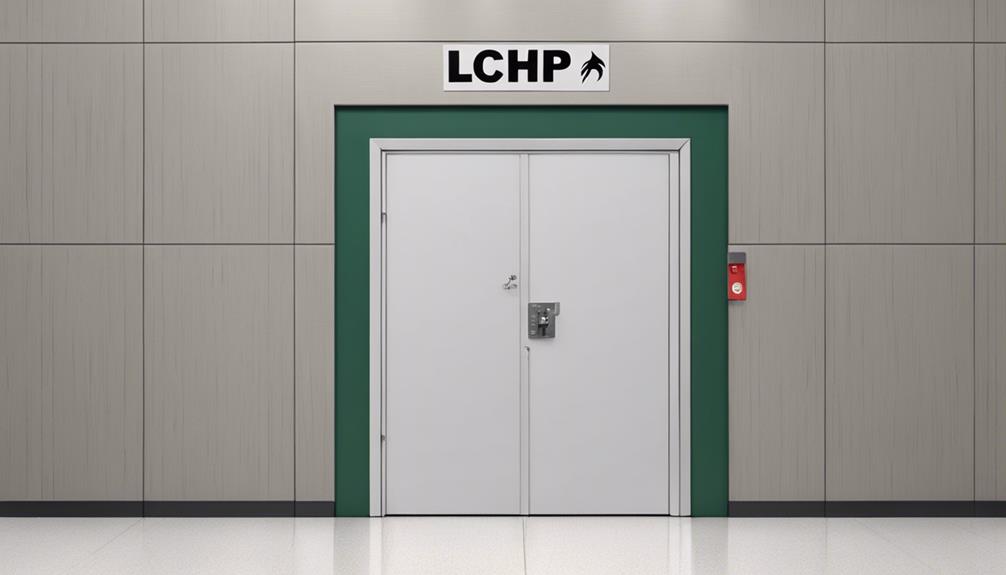
High-quality fire door locks are indispensable in ensuring both safety and compliance in emergency situations. Built from durable materials like steel, these locks are designed to withstand extreme heat and include features such as self-locking mechanisms and panic hardware for quick egress. I’ve seen firsthand how integrating these locks with access control systems not only enhances security but also provides peace of mind during emergencies.
Durability and material strength
The durability and material strength of fire door locks are essential, as these vital components must withstand the rigors of intense heat and pressure to guarantee the safety of building occupants during emergencies. High-quality fire door locks are often crafted from robust materials like steel, known for its exceptional resilience. I recall inspecting a facility where the locks had anti-corrosion coatings and reinforced construction, providing not just immediate security but long-term reliability. These locks are rigorously tested and certified to meet stringent fire safety standards, ensuring they maintain integrity under duress. Such strength and reliability are critical in preventing unauthorized access, ensuring that emergency exits function effectively when every second counts.
Ease of use and accessibility during emergencies
Building upon the robust durability and material strength of fire door locks, their ease of use and accessibility during emergencies are crucial to guaranteeing a swift and safe evacuation. High-quality fire door locks feature panic bars that enable effortless exits, even under duress. I recall a fire drill where the quick release of a panic bar made all the difference in an orderly evacuation. These locks are meticulously designed to function reliably, enduring the stress of emergency situations without fail. Accessibility is a critical consideration, allowing occupants to maintain control and confidence even in high-pressure scenarios. This ensures that, when seconds count, occupants can evacuate swiftly, mitigating risks and enhancing overall building security.
Compliance with fire safety regulations
When contemplating fire door locks for commercial buildings, how can one guarantee they meet stringent fire safety regulations while providing robust security and ease of use? High-quality fire door locks are meticulously designed to comply with these regulations, ensuring occupant safety during emergencies. These locks keep fire doors secure without compromising their ability to withstand fire for at least an hour. Features like panic hardware and keyless entry options not only enhance security but also maintain compliance. Additionally, fire door locks with delayed egress technology offer extra security in specific institutional settings. Personally, investing in compliant fire door locks is pivotal—it’s about safeguarding lives and property. Prioritizing locks that meet strict fire safety standards is an essential step for any responsible property manager.
Benefits of Installing Fire Door Locks
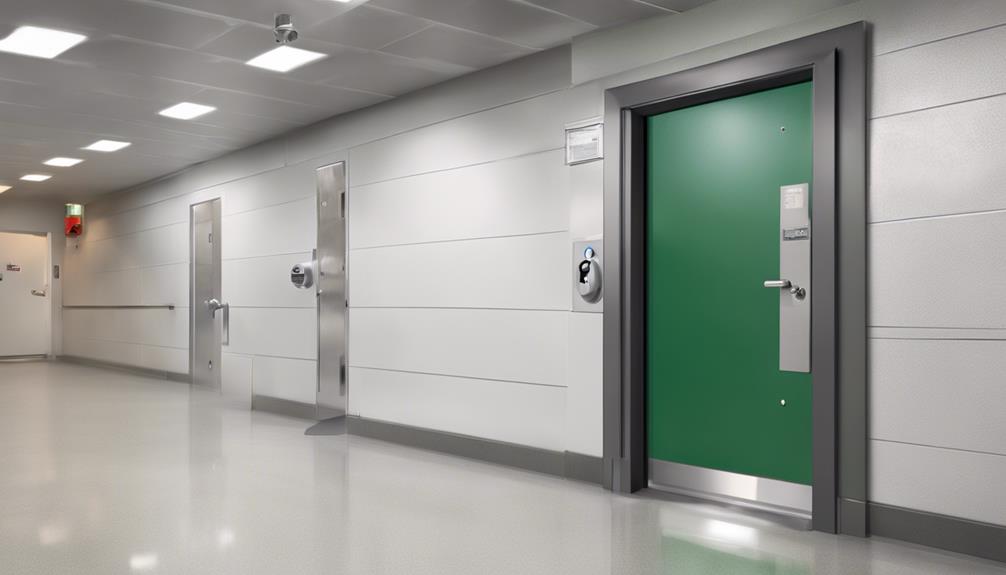
Installing fire door locks brings a multitude of benefits, such as enhanced security for building occupants and the prevention of unauthorized access to emergency exits. I recall a client who expressed immense relief knowing their commercial property was safeguarded against break-ins through these critical points. Additionally, these locks play a crucial role in the overall safety plan of a building, ensuring compliance with safety regulations and providing peace of mind in emergency situations.
Enhanced security for occupants
Enhancing security for occupants, fire door locks serve as an essential measure to prevent unauthorized access to emergency exits, ensuring that these critical pathways remain accessible solely during actual emergencies. Imagine the peace of mind knowing that you and your loved ones are safeguarded, not just from fires but also from potential intruders. These locks uphold the integrity of fire doors, pivotal in containing and suppressing fires, thereby providing a dual layer of protection. My personal experience in a well-secured building underscored the significance of such measures. Occupants can evacuate safely, aligning with stringent safety regulations and standards. This controlled security environment fosters a sense of safety and readiness, important for any responsible facility management.
Fire door locks are invaluable in preventing unauthorized access to emergency exits, guaranteeing that these critical pathways remain secure yet readily available during true emergencies. Imagine a scenario where an emergency exit is left unfastened and misused for theft or vandalism. This not only compromises security but can obstruct these essential routes when they are needed most. By installing fire door locks, you adhere to building codes and safety regulations, safeguarding against tampering or misuse. Personal experience has shown that locking these doors when not in use effectively deters unauthorized entry into restricted areas. This added layer of security ensures that emergency exits maintain their integrity, providing peace of mind and control over building access.
Contribution to overall building safety
In the domain of building safety, the strategic use of fire door locks greatly enhances the security and functionality of emergency exits. By compartmentalizing areas, these locks prevent the spread of fire and smoke, safeguarding lives and property. I recall a situation where a well-installed fire door lock in a client’s building contained a blaze, giving occupants vital time to evacuate. These locks are engineered to endure fire for at least an hour, preserving structural integrity. Additionally, they guarantee that emergency exits remain secure until needed, thwarting unauthorized access and boosting overall building security. Embracing fire door locks is not just a precaution but a proactive measure that ensures overall safety in any building.
Challenges and Considerations in Choosing Fire Door Locks
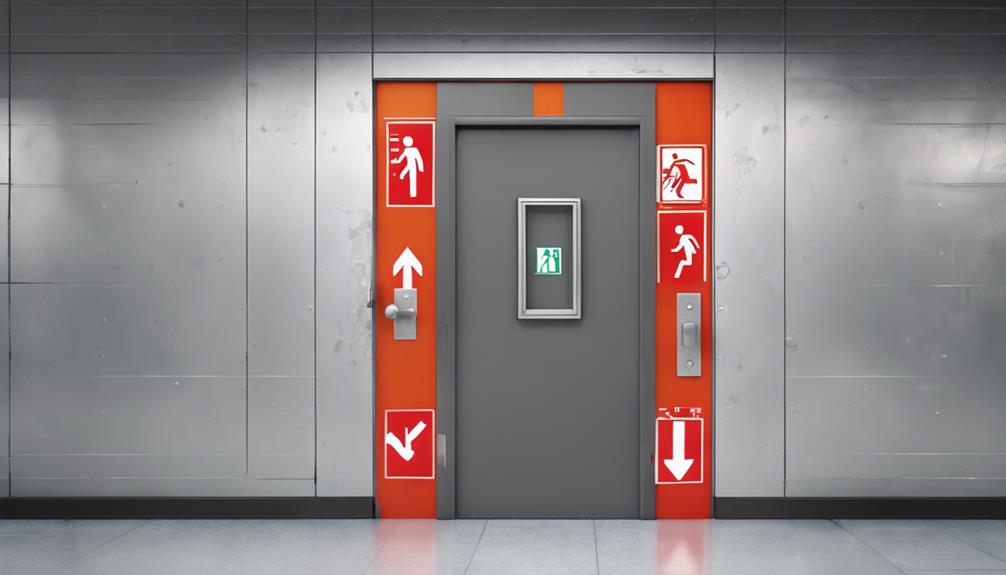
Selecting the right fire door lock involves maneuvering through a maze of compliance requirements, hardware compatibility, and the crucial balance between security and emergency egress. I vividly recall a project where ensuring the locks met stringent fire door ratings while still allowing for swift evacuation was a complex yet rewarding challenge. This section will explore common installation and maintenance hurdles, key selection factors, and how to achieve an ideal blend of safety and accessibility.
Common challenges faced during installation and maintenance
Ensuring proper alignment with the door frame during installation is an important yet often challenging aspect that can greatly impact the functionality of fire door locks. I recall an installation where even a slight misalignment compromised the lock’s efficiency, underscoring the need for precision. Regular inspections are essential for maintenance, ensuring locks remain operational and compliant with industry standards. Training staff on proper usage and maintenance is another essential component; it empowers them to identify and address issues proactively. Each of these steps, though demanding, ultimately fortifies the security of emergency exits. By embracing these challenges head-on, we can ensure our fire door locks perform effectively when it matters most.
Factors to consider when selecting the right fire door lock for your property
Selecting the appropriate fire door lock for your property requires thorough evaluation of various factors to guarantee both safety and security are uncompromised. First, confirm the lock’s fire rating matches the door’s rating to comply with safety standards. Panic hardware is essential for swift egress during emergencies. In my experience, opting for durable, tamper-resistant locks greatly enhances security. Compatibility between the lock mechanism and the fire door is vital for reliability. Additionally, consider whether key access or electronic locking systems suit your property’s security needs better. I once faced a dilemma choosing between traditional and electronic locks; understanding the specific requirements of the property helped make a confident, informed decision. This meticulous approach ensures maximum safety and security.
Balancing security with ease of emergency exit
Balancing security with ease of emergency exit frequently presents a complex challenge, demanding a nuanced approach that carefully weighs each building’s specific safety requirements against its security needs. Having installed fire door locks in various commercial settings, I’ve seen firsthand how essential it is to guarantee compliance with building codes while maintaining user-friendly emergency exits. One memorable project involved a hospital where the locks had to prevent unauthorized access but allow patients and staff to evacuate swiftly. Choosing durable locks that integrate key control and access restrictions without compromising emergency functionality was pivotal. Properly selected fire door locks not only safeguard assets but also ensure the safety of all occupants, creating a harmonious balance between security and emergency readiness.
Installation and Maintenance of Fire Door Locks
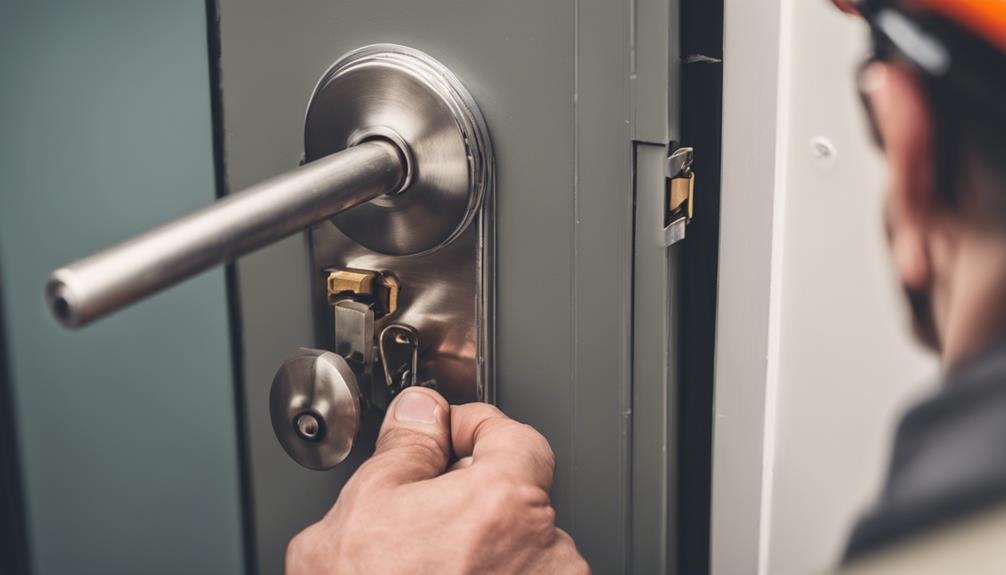
When it comes to the installation and maintenance of fire door locks, ensuring they are fitted by skilled professionals is paramount for their effectiveness in emergencies. Regular maintenance, including periodic inspections and functional checks, is essential to guarantee these locks perform at their best when needed most. I can personally attest to the peace of mind that comes from knowing every emergency exit is both secure and reliable, thanks to best practices in installation and upkeep.
Best practices for installing fire door locks
Guaranteeing fire door locks are installed correctly and maintained regularly is essential for both compliance with safety regulations and the protection of building occupants. I recall a project where we meticulously verified each lock met the stringent fire safety regulations and certification requirements. The key is to make sure these locks do not impede quick and safe egress during evacuations, a critical factor for any building’s safety protocol. Partnering with certified professionals for installation and inspection ensures that your fire door locks are functional and up to code. This proactive approach not only enhances security but also provides peace of mind, knowing the safety measures are robust and reliable. Therefore, proper installation is a cornerstone of effective emergency preparedness.
Regular maintenance tips to ensure optimal performance
Maintaining fire door locks to guarantee top performance is as important as their initial installation, and regular upkeep can prevent small issues from becoming significant safety hazards. I recall a client who avoided potential disaster simply by routinely lubricating hinges and locks, ensuring smooth operation during an emergency. By checking for proper alignment and functionality, you can avert misalignments that could compromise safety. Regularly testing the locking mechanism is akin to a preemptive strike against potential malfunctions. Annual inspections by certified locksmiths, like those at Low Rate Locksmith, are essential for compliance and peace of mind. These straightforward maintenance measures empower you to uphold building safety and security protocols, ensuring your emergency exits are always ready when needed.
Importance of professional installation and periodic inspections
Professional installation of fire door locks is paramount to guaranteeing compliance with stringent safety standards and regulations, safeguarding both property and lives. As a seasoned locksmith, I’ve seen firsthand how expertly installed fire door locks can make all the difference during emergencies. These locks are not just barriers; they are lifelines. Regular inspections by professionals are equally essential. They help identify wear and tear, address potential malfunctions, and ensure peak functionality. I recall a case where a routine inspection revealed a critical fault that could have compromised safety. Such diligence is non-negotiable. By entrusting experts, you gain control over the reliability and efficiency of your fire door locks, reinforcing the security of your emergency exits.
Common Myths and Misconceptions about Fire Door Locks

Understanding fire door locks is critical, yet many myths surround their purpose and functionality. One common misconception is that fire doors should be locked at all times for security, which can actually be dangerous and violate safety codes. By debunking these myths and providing accurate information, property owners can guarantee their buildings are both secure and compliant with safety regulations.
Debunking popular myths
How often have you heard the myth that fire door locks are meant to keep people out, rather than ensuring their safe exit during emergencies? This misconception couldn’t be further from the truth. Fire door locks are meticulously designed to maintain the door’s integrity in emergencies, allowing for quick and secure egress. Once, during a safety inspection at our office, we discovered that locking fire doors in non-emergency situations actually compromised our swift evacuation plan. The primary role of these locks is to prevent unauthorized locking, ensuring compliance with safety regulations. Misunderstanding their purpose can lead to significant risks and legal liabilities, especially in commercial properties. Understanding these facts empowers you to maintain safety and control effectively.
Clarifying common misconceptions
Misconceptions about fire door locks often stem from a lack of understanding about their specific purpose and functionality, leading to potential safety hazards and regulatory non-compliance. Fire door locks are not designed for everyday security but to guarantee the fire door’s integrity during emergencies. I once visited a facility where regular door locks were improperly used on fire doors, jeopardizing everyone’s safety. Proper fire door locks must facilitate smooth evacuation and resist fire for a specified duration. Misusing these locks can cause delays in evacuation and increase fire hazards. By recognizing their true purpose, property owners can secure compliance and enhance occupant safety, thereby maintaining control over their building’s emergency preparedness.
Providing factual information to help property owners make informed decisions
Many property owners are often misled by common myths about fire door locks, which can lead to dangerous practices and non-compliance with safety regulations. Contrary to popular belief, fire door locks are designed not to restrict access but to enhance safety by ensuring doors remain unfastened for swift evacuation. I recall a client who thought securing fire doors at night would increase security; instead, it jeopardized emergency exit routes. Ensuring these locks are maintained in an unfastened state is essential for compliance and safety. Misconfigured fire doors can obstruct evacuation and compromise structural integrity during fires. Understanding their proper usage is critical for safeguarding lives and property, ensuring emergency exits remain accessible and functional when needed most.
Integration with Other Security Systems
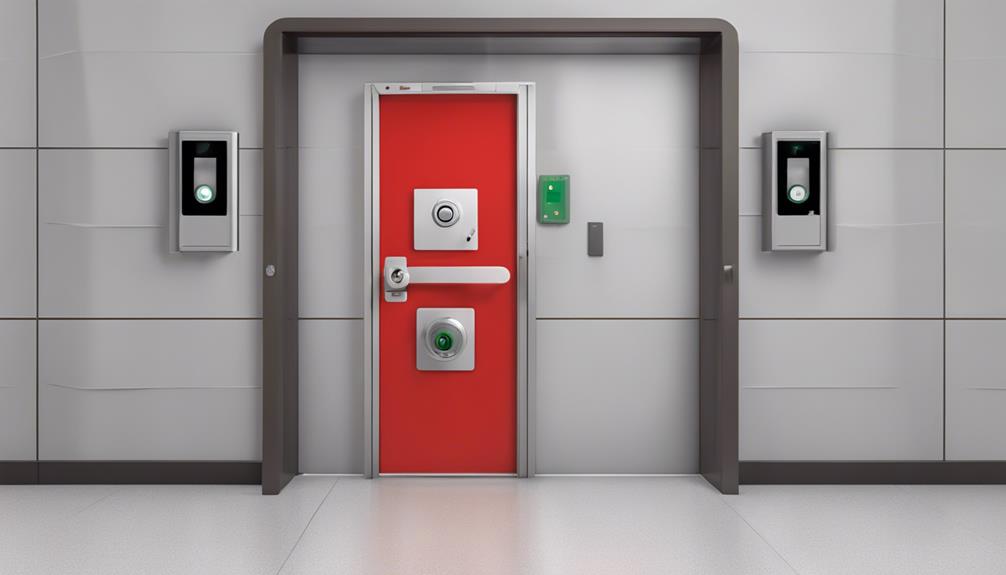
Integration of fire door locks with other security systems brings a new level of sophistication and reliability to building safety. By coupling these locks with access control systems, alarms, and cameras, facilities can achieve seamless centralized monitoring and control, ensuring that emergency exits are secure and easily manageable. This holistic approach not only improves incident response times but also enhances overall security, providing peace of mind for building occupants.
How fire door locks can complement other security measures
Incorporating fire door locks into a commercial building’s security infrastructure not only enhances emergency exit protection but also creates a synergistic relationship with access control systems, alarms, and surveillance cameras. Imagine a scenario where the fire door lock’s access logs synchronize with your building’s security network, providing a seamless, centralized control point. This integration allows for thorough audits and swift investigations, ensuring you are always in control. During an emergency, integrated systems improve response times, with alarms and cameras working together to offer real-time situational awareness. Personally, I’ve seen how such holistic security measures transform a building’s safety protocol, making not just emergency exits but the entire security framework more robust and efficient.
Examples of integrated security systems
A well-designed integrated security system can seamlessly combine access control, alarms, and surveillance cameras to create a fortified emergency exit strategy. Imagine having the ability to regulate who can access emergency exits, all while monitoring these points via real-time video feeds. Access control systems, for instance, guarantee only authorized personnel can use these exits, greatly enhancing safety. When paired with alarms, any unauthorized attempt to breach these exits triggers immediate alerts, enabling a swift response. Surveillance cameras provide an additional layer by capturing and recording any suspicious activities. This synergy of systems creates a robust security infrastructure, guaranteeing that every aspect of emergency exit security is thoroughly covered. This integration is not just efficient but also empowering for those who prioritize control.
Benefits of a holistic approach to building security
Enhancing building security through a holistic approach not only fortifies emergency exits but also guarantees a coordinated and efficient response during critical situations. Integrating fire door locks with access control, alarms, and cameras creates a seamless network that improves response times and minimizes risks. I recall a client whose integrated system provided important access logs during a security audit, revealing potential vulnerabilities. This proactive framework ensures a synchronized evacuation, safeguarding occupants effectively. Additionally, the collected data aids investigations, fostering a controlled and secure environment. By embracing a thorough security strategy, one not only bolsters emergency protocols but also cultivates a resilient and vigilant building infrastructure, ensuring safety and peace of mind for all occupants.
Conclusion
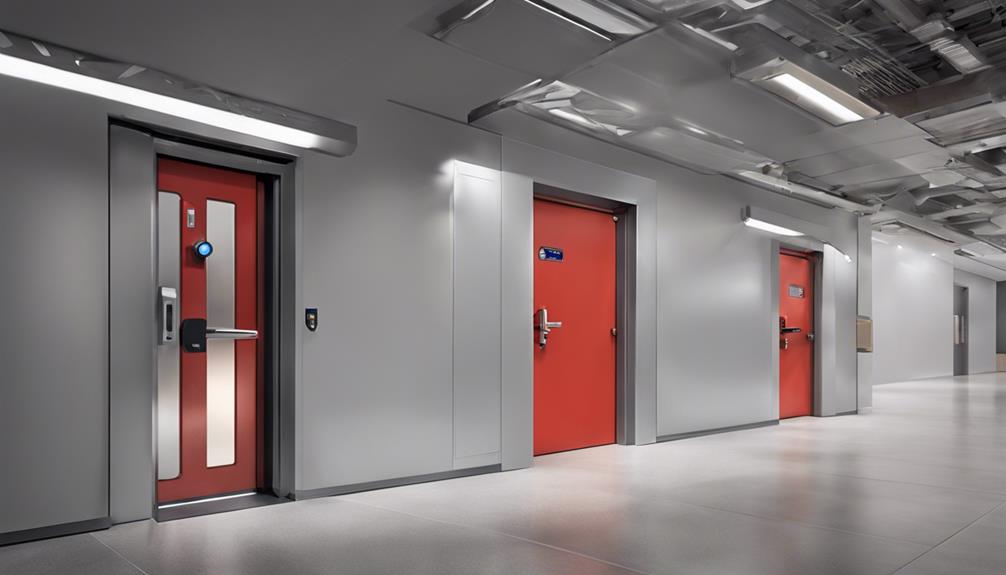
In conclusion, fire door locks are essential for both safety and compliance, offering strong security while ensuring easy egress during emergencies. Their role in maintaining the integrity of fire-rated barriers and controlling access cannot be overstated. For businesses keen on enhancing their emergency exit security, consulting with Low Rate Locksmith provides expert guidance and high-quality installation services.
Summary of key points discussed
Fire door locks are vital components that greatly enhance the security and safety of emergency exits, ensuring both compliance with regulations and the preservation of fire-resistant properties. From my experience working in building maintenance, I’ve seen firsthand the importance of high-quality locking mechanisms in maintaining a structure’s integrity. These locks prevent unauthorized access during non-emergencies, effectively securing the premises. Additionally, they are designed to activate only during emergencies, facilitating safe evacuation and minimizing potential hazards. Proper installation is essential, ensuring the locks contribute to compliance with building codes. Investing in robust fire door locks not only safeguards lives but also enhances the overall security measures of a building, providing peace of mind for all occupants.
Final thoughts on the importance of fire door locks in enhancing emergency exit security
Ultimately, the integration of robust fire door locks into a building’s emergency exit strategy is not just a regulatory necessity but a crucial measure that offers unparalleled peace of mind for everyone within the structure. During my tenure as a building manager, I witnessed firsthand how secure fire door locks prevented unauthorized access while ensuring occupants could evacuate swiftly in emergencies. These locks are more than mere compliance tools; they are essential for safeguarding lives and property. By investing in high-quality fire door locks, you are not only adhering to safety regulations but also fortifying your building against potential intruders and enhancing overall security. This dual functionality underscores their indispensable role in maintaining both safety and security in any facility.
Call to action encouraging readers to consult with Low Rate Locksmith for expert advice and installation services
To guarantee your building’s emergency exits are both secure and compliant, consulting with Low Rate Locksmith can provide you with expert advice and professional installation services tailored to your specific needs. Our team’s meticulous approach and deep understanding of regulations ensure that every fire door lock not only enhances security but also upholds safety standards. I recall a recent project where a client praised our seamless installation process, resulting in improved emergency exit security and peace of mind. By choosing Low Rate Locksmith, you gain control over your building’s safety with our reliable, customized solutions. Don’t wait—secure your emergency exits today with our expert guidance and high-quality services. Contact Low Rate Locksmith for unparalleled expertise and protection.
Frequently Asked Questions
What Are the Legal Requirements for Fire Door Locks?
Legal requirements for fire door locks mandate that they stay unfastened during normal operations, ensuring unhindered evacuation during emergencies. These locks must withstand fire for at least one hour and comply with specific standards. Additional locks, chains, or latches on emergency exit doors with panic bars are prohibited to avoid evacuation hindrances. Compliance with building codes and fire safety regulations is essential in the installation and maintenance of fire door locks.
How Often Should Fire Door Locks Be Inspected?
Imagine the peace of mind knowing your emergency exits are secure and compliant. Fire door locks should be inspected annually by a qualified locksmith. Regular inspections are essential to guarantee functionality and compliance with safety regulations. Just as you wouldn’t skip a yearly health check-up, don’t neglect these essential components. Personally, I’ve seen firsthand how proper maintenance can make all the difference in an emergency. Stay proactive, stay safe!
Are There Specific Brands Recommended for Fire Door Locks?
Certainly, there are specific brands recommended for fire door locks that guarantee optimal security and functionality. Von Duprin offers motor-driven capabilities, ensuring reliability. Marks USA provides durable, efficient locks through their mechanical expertise. Yale’s MELR technology delivers substantial power savings, making it cost-effective. Precision Hardware’s visual indicators aid swift identification of lockdown situations. Lastly, SDC’s Spectra Series, with built-in motorized latch retraction, is versatile for various commercial settings.
Can Fire Door Locks Be Customized for Different Types of Doors?
Definitely, fire door locks can be tailored to fit various types of doors, addressing the specific needs and regulations of a building. Customization options include different lock mechanisms, finishes, and compatibility with existing hardware. By evaluating the door type and security requirements, locksmith professionals can recommend the most suitable fire door lock customization, ensuring enhanced security without compromising the emergency exit door’s functionality and integrity.
What Should I Do if a Fire Door Lock Malfunctions During an Emergency?
Imagine the panic of a fire door lock malfunctioning during an emergency; what should you do? First, contact emergency services immediately. Avoid attempting repairs yourself to prevent further delays. Adhere to established evacuation procedures and use alternate exits if necessary. Regular maintenance and inspections can mitigate such risks. Guarantee everyone is informed about alternative routes to maintain control and safety during emergencies.

